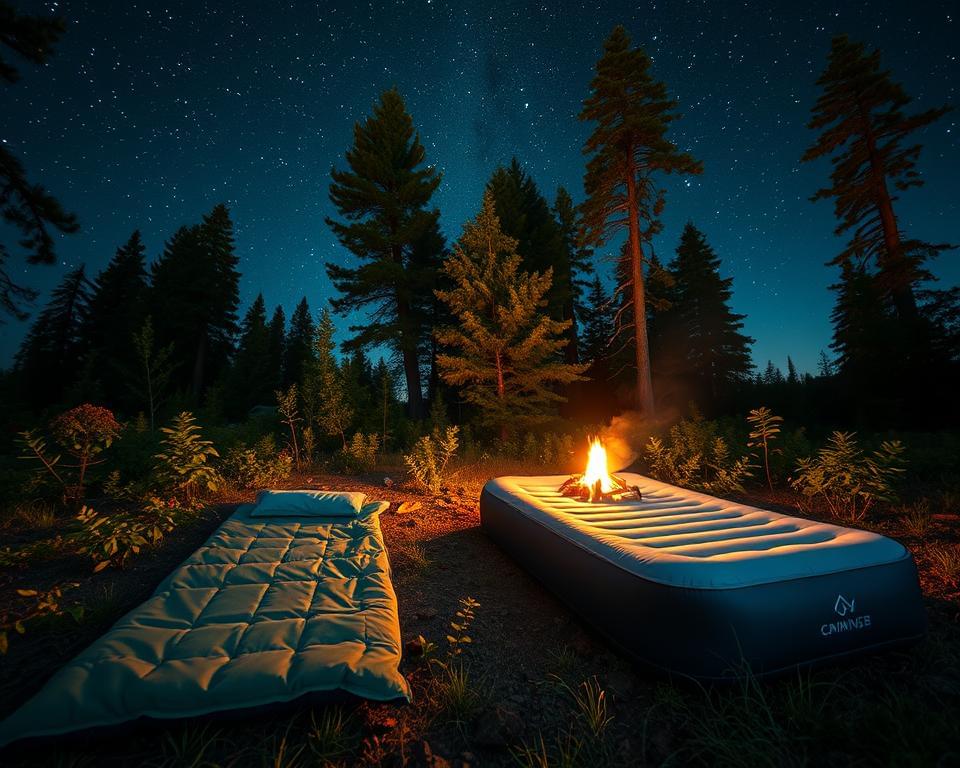Choosing the right sleeping gear for camping is key to a great trip. If you love the outdoors, you know comfort can change everything. It’s important to think about where and when you’ll camp, and what feels good to sleep on.
Both sleeping pads and air mattresses have their pros and cons. Self-inflating foam pads are light and comfy, liked by many backpackers. But, air mattresses give more comfort, perfect for family outings where it’s the main concern. Your sleep quality and camping fun really depend on what you pick.
Knowing the differences between sleeping pads and air mattresses is crucial. This knowledge will guide your choice. Let’s explore more so you can choose the best option for your adventure.
Understanding the Basics: Sleeping Pads and Air Mattresses
When camping, knowing the difference between sleeping pads and air mattresses is key. Each has its own benefits, depending on your camping style and needs.
Sleeping Pads: Lightweight Comfort
Sleeping pads are essential for those who favor light camping gear. They come in three types: foam, self-inflating, and air pads. Air pads, making up about 80% of the market, offer great comfort while being easy to carry.
Foam pads are tougher and last longer but are not as comfortable. Self-inflating pads are in the middle, offering comfort and insulation. They inflate quickly, within 5 minutes, which hikers love.
Air Mattresses: Elevated Comfort
Air mattresses bring the comfort of your bed outdoors. They’re perfect for campers who love comfort above all.
They are heavier and can get punctures more easily than pads. But, their comfort is unmatched, especially with built-in pumps and adjustable chambers. For car camping and long trips, they are the best, despite their weight.
Key Differences
Choosing between sleeping pads and air mattresses depends on your camping style and what you value in comfort. Backpackers prefer sleeping pads for their light weight and warmth. Pads with high R-values are best for cold climates.
Air mattresses give a deluxe sleeping experience, great for car camping. They’re heavy but so comfortable. Yet, they need more care and can easily get holes.
Picking the right bed for the outdoors ensures a better sleep in nature. Whether you choose a durable foam pad, a comfy self-inflating pad, or a cozy air mattress, it makes your trip more enjoyable.
Portability and Ease of Use
Choosing between a sleeping pad and an air mattress for camping is important. Each has pros and cons, depending on how you camp. Thinking about portability and how easy they are to use is key.
Sleeping Pad Portability
Sleeping pads, like self-inflating and foam ones, are super portable. They’re light, which is great for backpacking and hiking. You can roll them up tightly, making them easy to carry in or on your backpack.
Air Mattress Portability
Air mattresses are bulkier and heavier, not great for backpacking. But for car camping, they’re excellent. They offer comfort like you’re sleeping at home. Even though big, many have pumps that make inflating them easy.
Setup and Packing Convenience
Setting up and packing sleeping pads is usually easier. They’re great if you need to move camp fast. To inflate, just open a valve. To pack, roll up, secure, and you’re done.
Air mattresses offer more comfort but need more effort to set up. They might need pumps and can be hard to pack. Yet, for cozy car camping, they might be worth the extra work.
Comfort and Insulation
Picking between a sleeping pad and an air mattress can make a big difference in camping comfort. Let’s explore how each one does in providing comfort and keeping you warm.

Sleeping Pad Comfort
Backpackers love sleeping pads for their light weight and easy use. Options like the Nemo Switchback are quick to set up and tough. They don’t easily deflate.
These pads trap air with their unique design, keeping you warm at night. They may not be super soft, but they keep you warm outside. Plus, they can be used for more than just sleeping.
Air Mattress Comfort
Air mattresses are great for feeling like you’re sleeping on a real bed. They’re awesome for people who sleep on their sides or have back pain. But they might not keep you warm without extra insulation below.
They’re usually pricier but offer the utmost in softness. They are perfect for those who prefer comfort over carrying around easily.
Insulation Considerations
The type of sleeping pad you pick is key for staying warm. Closed-cell foam pads are excellent at keeping warmth in. They also resist moisture well.
But, inflatable pads and air mattresses might keep you warmer, though they cost more. Some campers use a foam pad under an inflatable one to stay even warmer and to avoid punctures.
Pros and Cons of Sleeping Pads and Air Mattresses
Choosing between sleeping pads and air mattresses is crucial for camping. Each serves different needs outdoors, coming with their own set of benefits and drawbacks.
Sleeping Pad Pros and Cons
Sleeping pads, especially foam types like the Therm-a-Rest Z Lite Sol, are light. They weigh around 14.5 oz, unlike the Nemo Tensor Ultralight Sleeping Pad, which is about 17.6 oz. Foam pads are easy to carry and set up, perfect for short naps or resting during hikes. They don’t cost much. For example, foam pads are less expensive than inflatable ones, fitting a backpacker’s budget.
However, foam pads have downsides too. Although tough and cheap, they’re not as cozy as air pads because they have low R-values of 2-3. This means they might not insulate as well as air pads from Nemo or Therm-a-Rest, which have R-values over 4.
Air Mattress Pros and Cons
Air mattresses are known for comfort and adjustable firmness, offering a bed-like feel. This is great for those who value comfort the most. But, air mattresses have issues too. They can get punctured or leak, causing hassle during camping trips. Blowing them up can be tiring after hiking. Plus, they’re bulky and heavy, which is not ideal for trekking far.
Temperature control is a key issue with air mattresses. They can’t regulate heat like memory foam mattresses from HEST, which align the body and manage heat well. Being cold or too warm can disrupt sleep. Also, they can be noisy when moving around on them, disturbing the quiet of camping.
Camping mattress choices often depend on these detailed points, helping campers decide what suits them best. While air mattresses offer tailored comfort, sleeping pads are praised for their durability, ease of handling, and affordability.
Is a Waterproof Sleeping Pad Necessary for Comfort When Camping?
A waterproof sleeping pad can significantly enhance your camping experience by providing comfort and insulation from the ground. When paired with waterproof or waterresistant boots, you can keep dry and warm, ensuring a restful night’s sleep despite wet conditions. Prioritize gear that works together for optimal camping comfort.
Conclusion
Deciding between a sleeping pad and an air mattress is a big choice for camping. Each has benefits and downsides. The best option depends on what you specifically need and like.
Sleeping pads are good if you want something easy to carry that keeps you warm. They come in foam, self-inflating, and air options. Foam pads are tough and warm but take up a lot of space. Self-inflating pads are a middle ground, more comfortable and easier to pack. Air pads are very light and you can adjust how firm they are, making them good for lots of campers.
Air mattresses, however, offer a lot of comforts. They’re high off the ground and you can change how firm they are. Many have built-in pumps and different sides for two people. But, they need more room to store and aren’t as easy to carry.
The best camping sleep setup depends on where you’ll be, the weather, how much room you have, and how you sleep. Getting a good night’s sleep is important, whether in a tent on hard ground or under the stars at a comfy campsite. If you love a deep, restoring sleep, think about getting a high-quality mattress like those from Puffy when you’re back home. They’re known for their comfort and long warranty.

